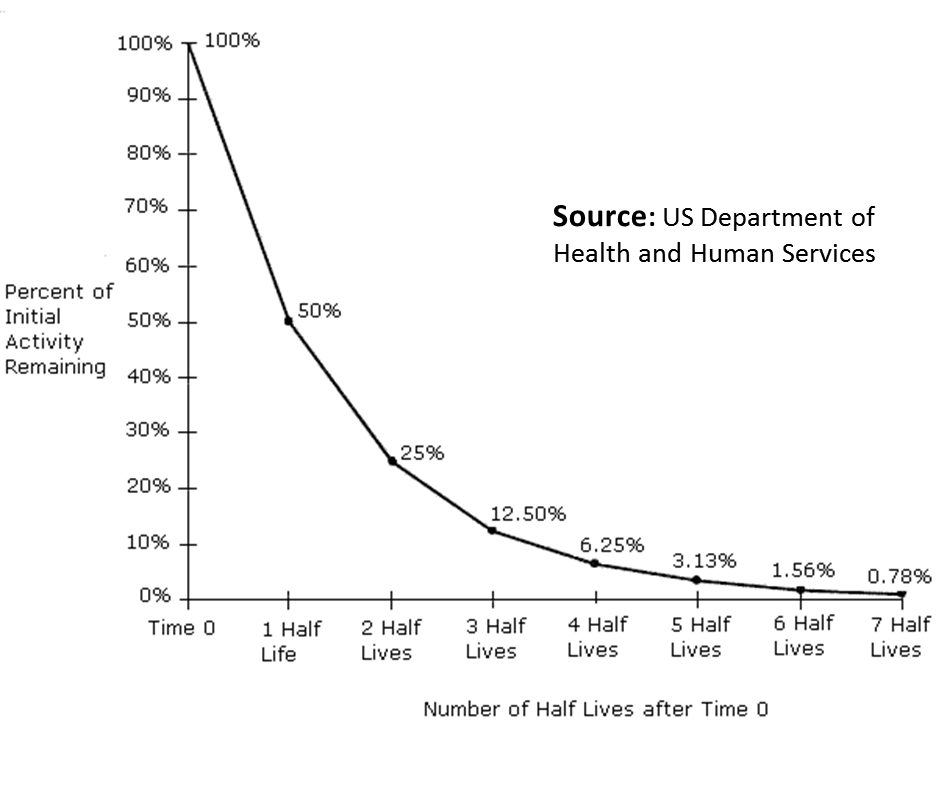Over two hundred radioactive isotopes are manufactured for use in medicine and industry. Radioisotopes can be used to analyze materials, trace flows and treat commodities. Here is a list of commonly used radioisotopes.
Americium-241 has a half-life of 432 years. It is used in backscatter gauges, smoke detectors, in measuring ash content of coal, in measuring toxic lead in dried paint, in measuring thickness in rolling processes for paper and steel.
Carbon-14 has a half-life of 5730 years. It is used to measure the age of water (up to 50,000 years). It is also used in biological research, agriculture, pollution control and in archeology to date artifacts.
Caesium-137 has a half-life of 30 years. It is used for radiotracer technique for identification of sources of soil erosion and deposition, in density and fill height level switches, to measure and control liquid flows in oil pipelines.
Chlorine-36 has a half-life of 400,000 years. It is used to measure sources of chloride and the age of water (up to 2 million years)
Chromium 51 has a half-life of 27.7 days. It is used to tag red blood cells.
Cobalt-60 has a half-life of 5.27 days. It is used in blast furnaces to determine resident times and to quantify yields to measure the furnace performance. It is also used for gamma sterilization, industrial radiography, density and fill height switches as well as in the development of industrial fuel oil burners.
Gold-198 has a half-life of 2.7 days. It is used to study sewage and liquid waste movements, as well as tracing factory waste causing ocean pollution, and to trace sand movement in river beds and ocean floors. It is also used to label sand to study coastal erosion and in blast furnaces to determine resident times and to quantify yields to measure the furnace performance
Hydrogen-3 has a half-life of 12.35 years It is used as a tracer to study sewage and liquid wastes and to measure 'young' groundwater (up to 30 years.
Iridium-192 has a half-life of 74 days. It is used in gamma radiography to locate flaws in metal components such as pipeline welds, boilers and aircraft parts..
Krypton-85 has a half-life of 10.72 years. It is used for industrial gauging, in indicator lights in domestic appliances, and to measure dust and pollutant levels.
Lanthanum-140 has a half-life of 40.272 hours. It is used together in blast furnaces to determine resident times and to quantify yields to measure the furnace performance.
Lead-210 has a half-life of 22.3 years. It is used to date layers of sand and soil up to 80 years.
Manganese-54 has a half-life of 312.5 days. It is used to predict the behaviour of heavy metal components in effluents from mining waste water..
Nickel-63 has a half-life of 96 years. It is used in light sensors in cameras and plasma display, in electronic discharge prevention, in electron capture detectors for thickness gauges and to detect explosives.
Polonium-210 has a half life of 138 days. It is used to reduce the static charge in the production of photographic film and other materials.
Promethium-147 has a half life of 2.62 years. It is used in electric blanket thermostats, and to gauge thickness of thin plastics, thin sheet metal, rubber, textile and paper.
Radium-226 has a half life of 1601 years. It was used in luminescent watch dials and is used to increase the efficiency of lightning rods.
Scandium-46 has a half-life of 83.83 days. It is used together in blast furnaces to determine resident times and to quantify yields to measure the furnace performance.
Selenium-75 has a half-life of 119.78 days. It is used in gamma radiography and non-destructive testing.
Silver-110m has a half-life of 249.9 days. It is used in blast furnaces to determine resident times and to quantify yields to measure the furnace performance.
Sodium-24 has a half-life of 15 hours. It is used to locate leaks in industrial pipelines, and in oil well studies.
Sulphur-35 has a half-life of 87.4 days. It is used in survey meters by schools, the military and emergency management authorities. It is also used in cigarette manufacturing sensors and medical treatment.
Strontium-90 has a half-life of 29.12 years. It is used for industrial gauging.
Technetium-99m has a half-life of 6.02 hours. It is used to study sewage and liquid waste movements, as well as tracing factory waste causing ocean pollution, and to trace sand movement in river beds and ocean floors.
Thallium-204 has a half-life of 3.78 years. It is used for industrial gauging.
Thorium-229 has a half-life of 7340 years. It is used to increase the lifespan of fluorescent lights.
Ytterbium-169 has a half-life of 32.01 days. It is used in gamma radiography and non-destructive testing.
Zinc-65 has a half-life of 243.9 days. It is used to predict the behaviour of heavy metal components in effluents from mining waste water.
